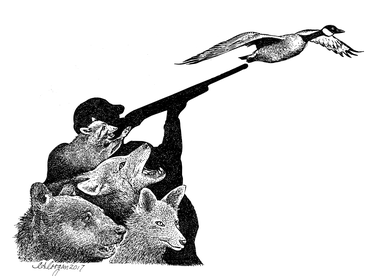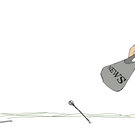Laws to protect what is left of the natural world must be implemented fairly
Who among us hasn’t looked skyward when we’ve heard the honking of Canada geese? As autumn approaches, their ragged Vs point south to warmer climes. They herald the coming of spring as well, returning north with warmer weather.
We’ve long loved the metaphor of shared responsibility etched against the sky with the changing seasons. Flying in front uses the most energy so the geese take turns to lead the wedge. That way, each helps the group reach its destination.
As a child, some 50 years ago, we read a novel called “The Strange One,” written by a Canadian naturalist and journalist, Fred Bodsworth. The book wove the stories of two unlikely pairs: a wayward barnacle goose from the Scottish Hebrides that mated with a Canada goose — geese are monogamous and mate for life — and a Scottish naturalist, tracking geese, who fell in love with a Canadian Cree girl.
The book has stayed with us all these years not just for the sweet romance at its center but more for the intricacies of the natural world it explored. So much is still beyond the ken of humankind.
We think of the Canada geese as nature’s clock, telling us with sure authority of seasonal change. But, this is not so. Like much in our modern world, human beings have altered the landscape so that what is natural is no longer an automatic given.
In the late 1800s and early 1900s, so much of the Canada goose’s natural habitat in this country had been destroyed and the geese had been so heavily hunted for their meat that, in the 1950s, the giant Canada goose was believed to be extinct. Gone. No more to walk the Earth or fly above it. But then, in 1962, a small flock was discovered, wintering in Rochester, Minnesota.
Through great human effort, a restoration program was launched and 64 breeding pairs were gradually increased over two decades to more than 6,000 geese being released in the wild at over 80 sites. Then, with habitat re-creation, preservation programs, and more stringent game laws over the next half-century the giant Canada goose has recovered most of its original range — a victory for human and goose alike.
But mankind’s effect on the environment has now caused an opposing problem. Humans have done away with most of the natural predators of the Canada goose’s eggs and goslings — gone are the coyotes and foxes and wolves; gone, too, are many of the brown bears and black bears, and even, in some places, the raccoons.
At the same time, people have built many bodies of water near food sources for the geese — on golf courses, in corporate and public parks, and in planned neighborhoods and retirement communities. The large strutting birds with the black necks and heads, and distinctive white chinstraps, are now a common sight.
While once they were fleetingly glimpsed as a marvel of nature, now, in many places, the Canada geese are considered pests — they leave droppings that are not only unsightly but can contaminate water sources with bacteria; and they can be loud and aggressive. Also, since the geese have interbred — migratory with nonmigratory subspecies — they are frequently now a year-round fixture in suburban and urban environments.
It is with this background in mind that we look at the case of a Westerlo man, William Kowal, who faces three charges from the state’s Department of Environmental Conservation for shooting a Canada goose. We can understand that a man like Kowal who is 77 and lives in the rural Helderberg Hilltowns is used to being self-reliant and solving problems as they arise.
He called The Enterprise and told his story to our Hilltown reporter, H. Rose Schneider, because he believes his arrest was unfair. Kowal is charged with possessing a loaded firearm on a motor vehicle, shooting within 500 feet of a dwelling, and taking migratory game out of season.
Kowal told us one of his tenants complained because a Canada goose was bothering her and that he has written permission in a lease agreement to fire a gun to take out pests near a tenant’s home. Also, Kowal says, he did not load his shotgun until after he got off the all-terrain vehicle he drove to the pond where the troublesome goose lived.
Kowal says he may be guilty of shooting a Canada goose out of season, but only because a permit he had applied for almost a year ago to legally kill the goose is still being processed.
We believe New York’s Department of Environmental Conservation, and other organizations like it in states across the country as well as our federal government, have not only the right but, indeed, the duty to protect wildlife. We need only look at the lesson provided by the near-extinction of the giant Canada goose to see that, without such protection, humans could obliterate species.
But, at the same time, such regulations must be implemented in a reasonable manner. It is not reasonable to have to wait a year for legal permission to kill a goose that is frightening a tenant. The Migratory Bird Depredation Permit, issued by the United States Fish and Wildlife Service, allows the killing of birds that damage crops, human health, or other wildlife.. That is as it should be.
Kowal himself had experienced contamination of his water when his family became sick with giardiasis in 2015, he said. Goose feces can spread germs like E. coli and salmonella as well as parasites such as giardia and cyclospora, according to a study by the National Wildlife Health Center.
H. Rose Schneider dug in to find the reason for the delay in Kowal’s getting the permit for which he’d applied. Within the last year, she found, the President’s Council on Environmental Quality offered its final guidance on greenhouse gas emissions and climate change in the National Environmental Policy Act. When this was withdrawn by the current administration in April, all federal agencies, including the Fish and Wildlife Service’s permitting process, were affected.
That could potentially leave citizens across the country, like Kowal — citizens who had gone through the proper channels to rid themselves of birds causing real problems — in the lurch.
While the environmental conservation officer who ticketed Kowal is not at fault for enforcing the law that is on the books, we urge the court hearing this case to look at the big picture and see that an unreasonable delay at the federal level is what caused Kowal to take matters into his own hands.
In short, laws must be made and followed to preserve what is left of the natural world we humans have disrupted. But, at the same time, the government agencies promulgating those regulations must see that allowable permits are issued in a timely fashion.
As humans, we can learn from the geese. We’re organized into governments with leaders that take the front spot to guide the rest of us. But each of us must be willing to take our turn at that apex if something is awry, to guide the flock on its safe journey.
— Melissa Hale-Spencer


